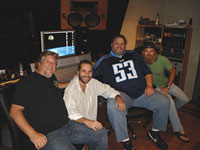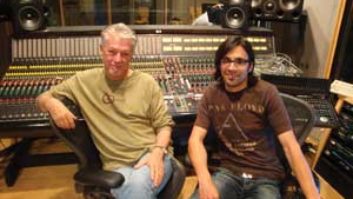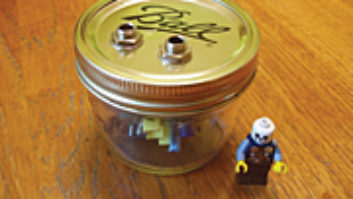
L-R: Jim “Moose” Brown, Kevin “Swine” Grantt, T.W. Cargile and Wayd Battle at Big Studios
Photo: Peter Cooper
They knew it was wrong, and they did it anyway. They gathered in a little place called Big Studios. They recorded Epiphone acoustic guitars direct. They played without rehearsing first. They didn’t use a click track. They mixed in the box via a Digidesign soundboard. They never went to tape. They used Shure SM57s for room mics. They wrote charts from cell phone recordings. And they wound up with one of the most compelling country music albums of the new century.
“I don’t care what it takes as long as it sounds good,” says T.W. Cargile, who manned the board for the recording of Jamey Johnson’s That Lonesome Song, an album that has won nearly universal praise and broken into the Billboard Top 10 country charts with a sound that is much more reminiscent of Waylon Jennings’ outlaw swagger than of the feel-good, minivan-friendly music that usually dominates the modern country mainstream.
“We didn’t even know we were making an album,” says Wayd Battle, who, along with several musicians and co-conspirators, is credited as co-producer on That Lonesome Song. (On the Mercury Nashville album, Johnson listed “The Kent Hardly Playboys” as producers.) “But then we started playing, and I was looking at Moose, and Moose was looking at Swine, and Swine was looking at Cowboy, and it felt like church in there. I called my wife, and said, ‘Something’s happening here. We’re not making demos.’”
Church? Swine? Cowboy? Moose? Ah, yes. Take a deep breath. Nashville is back. And it sounds like 1972, only it’s digital.
“I didn’t realize how much I didn’t like what was going on until I started producing some stuff,” says Jim Brown, the Kent Hardly Playboy who’s called “Moose.” “The typical way records are made in Nashville is a kind of wall of sound. There’s a couple of acoustic parts, a couple of electric rhythm parts, and then a piano and a Hammond B-3. They limit and compress everything so the level can stay hot all the time. When you need to go to a chorus and it needs to go somewhere else, you can’t; you’re already there. So sometimes the biggest parts of the song sound smaller. Because when everything kicks in, the compressors kick in harder ’cause you have to keep the vocals up front. And, well, that’s not how we did this one at all.”
The musicians learned the songs on the fly, with handwritten charts that Brown and Kevin “Swine” Grantt wrote out from the demos Johnson kept on his cell phone. Then the men stood and made music, in real time, with the acoustic guitar and bass recorded mostly direct into Pro Tools HD. Cargile hung Shure SM57s as room microphones to capture the guitar tones and drum sounds that rocketed through the small space, and most of the album was made in a day, between 2 p.m. and midnight.
“And that was stopping to take a drink every now and then,” says Grantt, who played his bass parts through a Vox DI using a Sadowsky Vintage 5 bass made of swamp ash.
The songs were often recorded without intros as such things require planning. Johnson, who had been released from a deal with Sony-BMG and gone through a divorce and no small number of hangovers prior to That Lonesome Song, just called friends together to play songs. Those songs wound up sounding altogether different from anything else being polished on Music Row, and Universal Records boss Luke Lewis decided to put the album out sounding as raw and real as Johnson wanted.
“Jamey was looking for something different, and so was I,” says Cargile, who spent 15 years at County Q studios before joining with Noah Gordan to lease the building off 18th Avenue that they’re calling Big Studios. “My whole reason for moving here was to get a specific sound. Thanks to Jamey, I got it. And we knew this wasn’t the way you’re supposed to record. It just felt right.”
That’s not to say that Big Studios doesn’t have fine microphones or capable gear. Johnson’s vocals were recorded into Pro Tools through a Manley Gold reference microphone, which Cargile praises for its substantial bottom end and tingling high-end edge. And the mixing took awhile, not because the basic tracks were problematic, but because Cargile spent time attempting to mix in a traditional manner, with outboard compression and all.
“I did the typical mix thing, started with drums and added bass and then compression,” Cargile says. “It didn’t sound right. It wasn’t vibing. So I went back to the roughs, added little touches, all in the box, and that was that.”
The mixing also took a little extra time because of all the revelry going on in the studio. The guys would start at about 2 p.m., and then by late afternoon it was time to amble down to a Nashville bar called Loser’s. There, they couldn’t help but talk up their unorthodox project, and by 6 p.m. there were usually 30 people or so who just had to go to the studio and hear what all the excitement was about.
“They all said the same thing,” Cargile adds. “It was, ‘I haven’t listened to country in years because it doesn’t sound like this anymore.’”
Jamey Johnson and his Kent Hardly Playboys would smile at that. It was Back to the Future stuff — via Pro Tools.
Send Nashville news to
[email protected].


